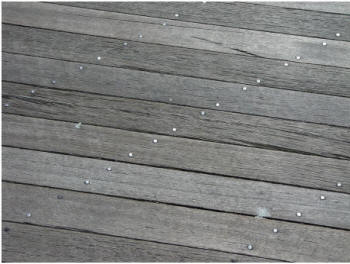What timber to use for decking - hardwood or softwood?
Basically the choice is between real wood -softwood and hardwood. There are also synthetic and polymer constructed boards which are used in the USA more than here in the UK at present. So will will simply discuss the pros and cons of softwood and hardwood. What timber to use for decking - hardwood or softwood?
There are other types of decking board available - composite deck boards and also Vinyl (UPVC) boards and systems. We will discuss those at a later stage. Most of these non wood decking materials are best installed by professional deck installers.
The main difference between softwood decking and hardwood decking is
the cost.
- Hardwood decking is cut from trees with a slow growth habit - typically like those from rainforest areas - and therefore cost more to produce. There should be no environmental concerns these days. Most timbers used in decking are farmed properly, and re-planted to ensure continuity.
- Softwood decking is cut from coniferous trees which are quicker growing and therefore more economical. Soft wood comes from sustainable sources - mainly Europe - where there are huge areas of coniferous trees 'farmed' as with normal crops. Every cut tree is 'replaced' - many times over in some cases where forestry is expanding. Softwoods are normally sold as 'redwood' or 'whitewood'.
- Redwood and whitewood, simply refer to the grade of timber rather than the type of tree or colour of the wood! The types of conifer normally used for softwood decking include Pine - Pinus spp; Cedar - Thuya - or Thuja spp; Spruce - Picea - same as traditional Christmas tree; Hemlock - Tsuga; Fir - Abies spp: These will be sold as European Pine, European Redwood, Larch and Cedar to name but a few!
- Hardwood is not better than softwood. It is simply different. Hardwood needs a greater expertise in carpentry skills than does softwood. Together with that, different or additional tools will be required. Additional work will be needed by way of pre-drilling and screwing - rather than nailing. Hardwoods normally used in decking, include Ipe, Yellow Balau, Teak - rarely, Massaranduba.
- Red Cedar decking is not to be confused with proper Cedar! Red cedar is produced from a quick growing conifers, but has a natural oil which combats decay - providing it is not in contact with the ground. Red cedar is a conifer softwood. It is a bit misleading to call it simply 'Cedar' which conjures up visions of huge churchyard-type trees being cut down. Not so. 'Cedar decking comes from the relatively common species of conifer - Thuya
Softwood is not necessarily soft - nor hardwood hard! Both types of wood are suitable for decking, and a properly treated and maintained softwood deck can last up to 40 years.

All timber used in an exterior situation, end up the same colour if it is not treated or stained in some way - grey! A softwood deck - if stained, can look similar to hardwood. A large timber supplier recently had a picture of a softwood deck on their website - built by Top Deck Decking Ltd, and stolen from their website - claiming that it was hardwood! We pointed out their error!
When new, most hardwoods will either have a golden brown or red/brown appearance. Treated softwood will typically be light green/brown, and after just a few weeks exposure to light, will turn what is best described as 'honey-brown'.
The vast majority of decks in the UK are constructed from commercially treated (tanalised) softwoods. Typically, the guarantee against rot - providing that all cuts are properly treated - will be 15 years. You can expect a properly constructed deck to last many years longer than that.
A typical stack of good quality softwood decking. The colour soon changes to honey brown
Below - A disaster of a hardwood deck!

The image on the left is not typical of quality hardwood decking, but
serves as a warning. In this instance, the installers were the same
company that provided and installed the swimming pool. Obviously not
experienced in deck work - either choice of materials or craftsmanship.
They used masonry nails to fix the decking!! Whilst hardwood decking
'could' be nailed, the choice of nail would centre around a ridged or
ring shanked nail to ensure extra grip and negate the risk of popping! A
Smooth masonry nail does NOT fit this specification.
A 6 month old hardwood surround to a swimming pool! Note the splits starting - for a bare feet area!
1 - Building a Deck : 2 -
Versatility of Decking : 3 - What Decking
Timber : 4 -
Designing the Deck - The Plan :
5 - Building The Decking
Sub Frame Base : 6 -
Sub Deck Frame Images :
Best Selling Gardening Products
Popular Gardening Sections

Problems
Identify Weeds in The Garden - How to deal with weeds. Diseases and Pest which harm your garden and plants, learn how to prevent, deter and erradicate your garden problems.
Garden Problems
Pruning
Pruning Guide. Shrubs flower better with correct pruning. Many illustrations and examples of what to do - and when. Includes evergreens, roses, flowering shrubs, spring flowering shrubs and pruning for stem effect. This is our most viewed and comprehensive section,
Pruning
Gardening Businesses
Gardening Businesses listed in the UK counties and USA states. County and State Listings of businesses involved in Garden supplies and services. If you wish to be added to the Directory, please send us your information. Having problems, use the search box
Businesses
Gardening
In this section you will learn about Gardening Basics, Containers, Landscaping, Propagation and Soil.
Gardening
Gardening Gifts
Gardening Gifts and Reviews, Read Before you Buy
- Gardening Gifts Ideas
- Gifts For Her
- Gifts For Men
- Power Tool Gifts
- Cheap Gifts
- Personalised Gifts
- Wildlife Gifts
- Family Gifts



